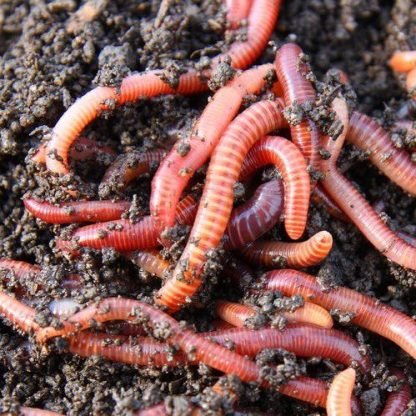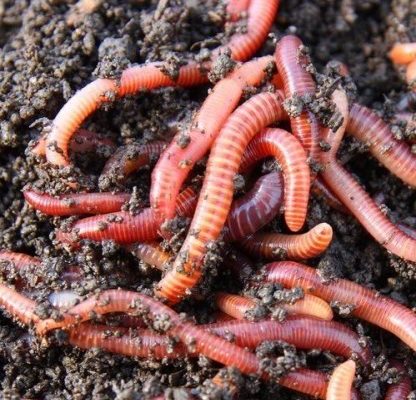
Red wigglers, or *Eisenia fetida*, are a type of earthworm often associated with composting. Their primary job? To break down organic material and enrich the soil. Think of them as tiny composting machines, turning kitchen scraps and yard waste into nutrient-rich compost that plants love. But their influence stretches beyond just the soil—red wigglers also play a crucial role in aquatic ecosystems, helping to maintain balance and health in our waterways.
Curious about how these worms do all this? Grab a cup of coffee, and let’s dig into the fascinating world of red wigglers!
What Are Red Wigglers?
Red wigglers are a specific species of earthworm that thrives in compost piles and rich, organic soils. They are about 3 to 4 inches long, with a reddish-brown color that makes them easy to spot in the compost. Unlike typical earthworms that dwell deep in the soil, red wigglers prefer to stay near the surface. This is because they feed on decomposing material and organic matter found there.
These worms reproduce quickly, which aids in their role of breaking down waste. They can survive in a variety of environments, making them adaptable and efficient performers in both terrestrial and aquatic ecosystems. Their bodies are made up of segments, allowing them to move easily through soil or water, consuming organic material as they go.
You might be wondering why they are so important. Well, their munching not only helps recycle nutrients but also aerates the soil, improving its structure and helping plants grow stronger. It’s like having a tiny gardener working tirelessly underground!
The Role of Red Wigglers in Soil Ecosystems
In soil ecosystems, red wigglers are powerhouse recyclers. They consume organic waste—think fruit peels, vegetable scraps, and yard waste—and break it down into rich compost. This compost is loaded with nutrients like nitrogen, phosphorus, and potassium, essential for plant growth.
Here’s the thing: as they digest this organic material, red wigglers leave behind castings, which are worm poop but way cooler. Castings are more nutrient-dense than regular soil and can help plants grow healthier and more resilient. It’s like nature’s fertilizer—no synthetic chemicals needed!
Additionally, their tunneling action aerates the soil. When worms burrow, they create small channels that allow air and water to penetrate deeper, improving drainage and root access. This not only benefits plants but also encourages other beneficial soil organisms, promoting a vibrant and balanced ecosystem.
The Impact on Aquatic Ecosystems
Believe it or not, red wigglers aren’t just limited to gardens and farms—they also play a role in aquatic ecosystems. In ponds and wetlands, these worms contribute to the breakdown of organic matter that accumulates in the water. When leaves, bark, and other debris fall into these environments, red wigglers help decompose that material, returning nutrients back into the water.
This is vital for aquatic plants and animals. The nutrients released through their decomposition process support the growth of underwater vegetation, which serves as food and habitat for fish and other aquatic creatures. Essentially, red wigglers help keep the food chain in balance, sustaining life from the smallest microorganisms to larger animals.
Imagine a pond without these little guys—eventually, it could become choked with debris, leading to poor water quality and less biodiversity. Thanks to red wigglers, aquatic ecosystems can thrive!
Composting with Red Wigglers
If you’ve ever thought about composting at home, red wigglers are your best friends. Worm composting, or vermicomposting, is a simple and effective way to recycle kitchen scraps into nutrient-rich compost. You might wonder how to get started, and luckily, it’s not too complicated!
First, you’ll need a worm bin. You can buy one or make your own using a plastic tote. The key is to provide a comfortable environment for the worms, which means giving them a mix of damp bedding—like shredded newspapers or cardboard—and food scraps. Red wigglers love things like fruit and vegetable peelings, coffee grounds, and crushed eggshells. Just avoid adding meat or dairy, as it can attract pests.
Once your bin is set up, simply add the worms and let them get to work. They’ll break down the waste over time, and before you know it, you’ll have rich compost to feed your plants. It’s a win-win situation!
Benefits of Red Wigglers for Your Garden
Integrating red wigglers into your gardening routine has plenty of perks. First off, they help reduce waste by turning kitchen scraps into compost, which means less trash in landfills. Plus, the nutrient-rich compost they produce enhances soil health, leading to more productive plants.
Another cool aspect is that red wigglers can help protect against pests. Their casting contains beneficial microbes that can suppress diseases and deter harmful pests. So, while you’re growing your garden, you’re also promoting a healthier ecosystem around your plants.
Finally, having red wigglers in your garden reduces the need for chemical fertilizers. Using natural compost not only feeds your plants but also fosters a better environment for beneficial insects, which can help with pollination and pest control. It’s like creating a little sanctuary in your backyard!
Challenges and Considerations with Red Wigglers
While red wigglers are fantastic for both soil and aquatic ecosystems, they do come with challenges. One major concern is temperature. Red wigglers thrive best in moderate temperatures, ideally between 55°F and 77°F. If it gets too hot or too cold, they can become stressed or even die.
Another consideration is moisture. These worms need damp conditions to survive, but too much water can drown them. It’s essential to find a balance to keep your red wigglers happy and healthy.
Lastly, if you’re using them in an aquarium or pond, be mindful of their compatibility with other species. Some fish or aquatic creatures may prey on worms or compete for the same food sources. Always research beforehand to ensure harmony in your ecosystem.
The Future of Red Wigglers in Environment Conservation
The role of red wigglers in soil and aquatic ecosystems is becoming more critical as we face environmental challenges. Their natural composting abilities help promote sustainable practices, reducing the strain on landfills and providing organic options for maintaining soil health.
As more people embrace composting at home, the demand for red wigglers is likely to grow. This trend can lead to eco-friendly solutions that not only nurture our gardens but also contribute positively to the environment.
You might not have thought much about worms before, but these little wrigglers are a big part of the solution to a healthier planet. By learning to appreciate and utilize them, we can take steps toward sustainable living and environmental stewardship.
In conclusion, red wigglers are more than just backyard buddies; they are vital players in both soil and aquatic ecosystems. Their ability to break down organic material, enrich the soil, and support diverse habitats makes them indispensable. Whether you’re composting at home or appreciating the role they play in nature, these little worms deserve a place in our hearts and our gardens.

